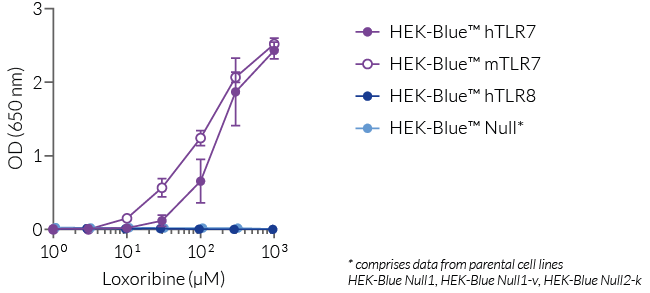Loxoribine
| Product | Unit size | Cat. code | Docs. | Qty. | Price | |
|---|---|---|---|---|---|---|
|
Loxoribine Guanosine analog |
Show product |
50 mg |
tlrl-lox
|
|
TLR7 Agonist - Guanosine analog

TLR7 activation with Loxoribine
 InvivoGen also offers:
InvivoGen also offers:
• TLR reporter cells: HEK293, RAW, THP-1 cells
• TLR research tools: Antibodies, Inhibitors, etc.
Loxoribine is a guanosine analog derivatized at positions N7 and C8. Loxoribine is a strong Toll-like receptor 7 (TLR7) agonist. It does not stimulate TLR8. TLR7 and TLR8 are endosomal pattern recognition receptors that play an important role in the antiviral immune response [2].
Mode of action
This nucleoside is a very powerful stimulator of the immune system but until recently the mechanism responsible for this immunostimulatory activity was unknown [1]. It appears that similarly to imiquimod, another TLR7-specific ligand and small synthetic antiviral molecule, loxoribine activates the innate immune system through Toll-like receptor 7 and that this activation requires endosomal maturation [2].
Using our HEK-Blue™ reporter cell lines expressing human or mouse TLR7 or TLR8, we demonstrated that loxoribine is a human and mouse TLR7-specific agonist. It does not stimulate TLR8, even at high concentrations (see figure).
Key features of Loxoribine
- Specific agonist of human and mouse TLR7
- Does not activate TLR8
- Each lot of loxoribine is highly pure (≥95%) and functionally tested
References:
1. Schön M.P. & Schön M., 2008. TLR7 and TLR8 as targets in cancer therapy. Oncogene. 27:190-199. 1. Gorden KB. et al., 2005. Synthetic TLR agonists reveal functional differences between human TLR7 and TLR8. J Immunol. 174(3):1259-68.
2. Heil F. et al., 2003. The Toll-like receptor 7 (TLR7)-specific stimulus loxoribine uncovers a strong relationship within the TLR7, 8 and 9 subfamily. Eur J Immunol. 33(11):2987-97.
Specifications
Working concentration: 1 mM (300 µg/ml)
CAS number: 121288-39-9
Specificity: human/mouse TLR7 agonist
Solubility: 100 mM in DMSO
Quality control:
- Purity: ≥95% (UHPLC)
- The biological activity of Loxoribine has been validated using cellular assays.
- The absence of bacterial contamination (e.g. lipoproteins and endotoxins) has been confirmed using HEK-Blue™ hTLR2 and HEK-Blue™ hTLR4 cells.
Contents
Loxoribine is provided as a white to off-white solid.
- 50 mg (147 μmol) Loxoribine
- 25 ml sterile endotoxin-free water
![]() Loxoribine is shipped at room temperature.
Loxoribine is shipped at room temperature.
![]() Store product at 4°C.
Store product at 4°C.
Details
TLR7 and TLR8
TLR7 and TLR8 are endosomal pattern recognition receptors that share structural homology [1]. Both receptors are activated by single-stranded RNA (ssRNA) molecules, however, they exhibit different ligand-binding specificities and cellular expression patterns suggesting that they have nonredundant specialized roles.
TLR7 is essentially expressed by plasmacytoid dendritic cells (pDCs) but is also found in B cells and other myeloid cells [2] while TLR8 is highly expressed by myeloid cells and is absent from pDCs and B cells [2].
The endosomal distribution of TLR7 and TLR8 allows them to scan for the presence of microbial RNA in the phagocytic cargo. Their activation leads to NF-κB-, AP1-, and interferon regulatory factor (IRF)-mediated production of type I interferons (IFN-α/β) and pro-inflammatory cytokines [2].
Structural analyses have revealed that both TLR7 and TLR8 possess two binding sites (designated as Site 1 and Site 2) which do not share the same specificities.
Site 1 is highly conserved between TLR7 and TLR8 and binds nucleosides (guanosine (G) for TLR7 and uridine (U) for TLR8) or base analogs. The ligand preference for TLR7 and TLR8 is thus explained by the presence of specific residues in Site 1. Site 1 occupancy allows receptor dimerization and signaling.
Site 2 is less conserved and binds ssRNA with U(U) and U(G) motifs, respectively [3, 4]. Of note, ssRNA-binding to Site 2 is not sufficient for the formation of a signaling-competent TLR dimer but it strongly enhances the binding affinity of Site 1 [3, 4]. Thus, TLR7 and TLR8 appear to sense distinct RNA-degradation products rather than full-length ssRNAs [4].
1. Chuang T.H. & Ulevitch R.J., 2000. Cloning and characterization of a sub-family of human toll-like receptors: hTLR7, hTLR8, and hTLR9. Eur Cytokine Netw, 11:372-8.
2. Georg P. & Sander L.E., 2019. Innate sensors that regulate vaccine responses. Curr. Op. Immunol. 59:31.
3. Zhang Z. et al., 2018. Structural analyses of Toll-like receptor 7 reveal detailed RNA sequence specificity and recognition mechanism of agonistic ligands. Cell Rep. 25:3371.
4. Tanji H. et al., 2015. Toll-like receptor 8 senses degradation products of single-stranded RNA. Nat. Struct. Mol. Biol. 22:109.
Chemical structure of loxoribine






